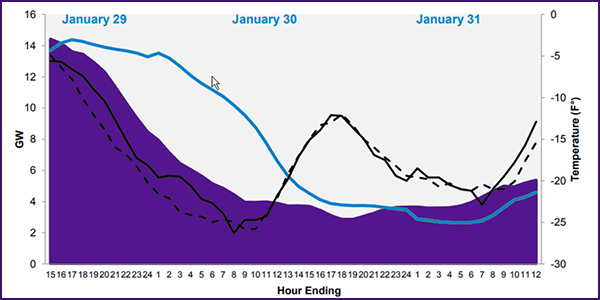By Holden Mann
North America’s grid has adequate resources to meet projected energy needs this winter, but a new NERC report shows the agency remains concerned about unpredictable circumstances — such as severe weather — and the accuracy of existing generation and demand forecasting tools.
NERC’s 2019-2020 Winter Reliability Assessment found every assessment area had sufficient anticipated reserves to meet or exceed its target level for the December-February period, and regional entities are making progress mitigating known risk factors.
But those findings are not as reassuring as they might seem at first glance, since reserve targets are based on normal demand and average weather conditions, and severe weather events could easily throw off predictions. For instance, extreme temperatures in the South Central U.S. in January 2018 led to season-high loads and increased generator outages across nine states. Large power transfers were needed to compensate for the outages, creating transmission constraints throughout the South, NERC noted. (See FERC, NERC to Probe January Outages in MISO South.)
NERC identified MISO, SPP and ERCOT as particularly susceptible to reliability risks over the next several months due to extreme weather events. Both MISO and SPP reported they are working with neighboring reliability coordinators to implement “enhanced communications and operating procedures for joint actions during emergencies.” ERCOT, which expects the greatest impact from curtailment of natural gas supply rather than cold temperatures, plans to bring sufficient generating capacity from other sources online to cope with any potential issues.
Overwhelming Infrastructure
ISO-NE was also singled out over worries “that energy could be insufficient to satisfy electricity demand during an extended cold spell.” While the generating capacity in the region is theoretically adequate to meet the peak demand forecast, the “evolving resource mix and fuel delivery infrastructure” are a bigger cause for concern, particularly the potential for natural gas pipelines to be overloaded by combined demand for both heating and power generation.
The RTO has implemented several measures to address this risk, including the 21-Day Energy Assessment Forecast and Report. This forecast was introduced in 2018 to help market participants plan their fuel buying through “early indication of potential fuel scarcity conditions” and will continue to be provided through this winter. ISO-NE has also committed to surveying fossil fuel generators on a weekly basis to confirm their fuel availability to meet short- and long-term obligations.
Managing Wind Forecasts
Volatility of supply is an even greater issue for wind energy, which depends on weather patterns that can be fickle, particularly in winter. The report observed over a three-day period during the January 2019 cold snap, MISO’s day-ahead predictions for wind energy production were at times far out of step with realized generation, leading to emergency procedures such as voluntary load reduction and the issuance of energy emergency alerts to make up the difference. (See MISO: Winter Emergency Another Signal for Grid Ops Change.)

MISO Wind Generation during January 2019 Cold Snap | MISO
Wind is still a relatively minor part of the overall electric grid, but its contribution has grown considerably in several regions. For instance, in ERCOT it is expected to provide more than 7% of on-peak capacity this winter, up from just over 1% in 2014/15. For this reason, the report encouraged operators in areas with variable generation resources to address the risks of inaccurate forecasts, including working with generator owners to improve models.



